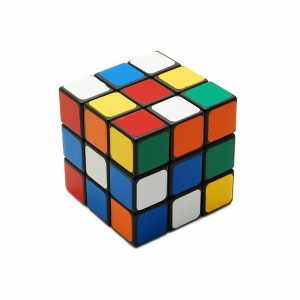The Rubik’s Cube Challenge

Back in the 1980’s, I along with many other kids in the United States owned a Rubik’s Cube. I spent hours twisting and turning the little colored squares on this perplexing cube trying to get all of the colors to line back up on each of the six faces. Eventually I did solve it, but only after many months of frustration and effort.
I was not alone in my frustration. Only about 6% of people who owned a Rubik’s cube could actually solve it. Dave had one too and never figured it out. (He claims that he could have solved it, but it just got too boring for him. I’m skeptical…:-)
The Rubik’s cube is a highly complex puzzle. It’s advertised as having “billions” of combinations. In reality, it has about 43 quintillion possible arrangements – that’s 43 with eighteen zeroes behind it. To put that in perspective, if you had a Rubik’s cube set to each possible combination, you’d have enough of these little toys to cover the entire earth’s surface 275 times!
So, how does this relate to achieving goals that are complex? In their book, The Answer, John Assaraf and Murray Smith use the following example to make this connection.
Close your eyes and imagine walking into a room. You see a stool in the center of the room with a Rubik’s cube perched atop it and a man with a stopwatch.
The man turns to you and says, “Hello! I will give you $1 million if you can solve this Rubik’s cube in twenty minutes or less!”
Unless you are a world class “speedcuber,” you’d have no chance. Most people take days, weeks or months to solve this puzzle, if they can do it at all. However, Kevin Hays, one of the best speedcubers at the world championships in Vancouver in 2013, was routinely solving the cube in less than two minutes.
The Blindfolded Rubik’s Cube Challenge
OK – now close your eyes again. Imagine the same room with the same stool, Rubik’s cube, man and stopwatch. But now also imagine that you see a blindfold sitting on the stool and none other than Kevin Hays standing in the room as well.
Once again, the man with the stopwatch turns toward you, but this time he says, “I will give you a million dollars if you can solve the Rubik’s cube blindfolded in twenty minutes or less!”
Doing this alone is an even more impossible challenge than the first scenario!
However, (and this is the linkage with how to achieve goals that are complex) what if after each of your moves, Mr. Hays simply said, “Yes” if it was a good move and “No” if it was a bad move? How would you feel about the challenge then?
Let’s go a step further. What if instead of just saying “Yes” or “No,” Mr. Hayes was allowed to give you explicit instructions on how to manipulate the cube? How much would Mr. Hays’ assistance be worth to you? $1,000 for a chance at a $1 million? $5,000? $25,000?
How To Achieve Goals That are Complex
When you are faced with a complex goal and you want to move forward quickly because it’s important to you, keep the two lessons of the Blindfolded Rubik’s Cube challenge that is described in John Assaraf’s The Answer in mind:
- Seek out the assistance of others. Utilize existing relationships or establish new ones with people who can help you solve the challenges you are facing. In particular, find people who are already experts at solving the challenge you face.
- When necessary, be willing to pay for high quality information that will speed up your progress. You can literally eliminate weeks, months or even years of frustration and fruitless effort by seeking out the right information from experts.
Your Assignment:
Think about your biggest, most complex goal. Get out a pad of paper and pencil and answer the following questions:
Answering these questions will get you moving forward on even the most challenging tasks!
